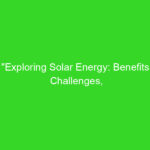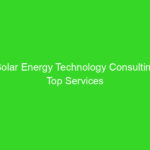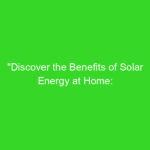
What is the Difference Between Active and Passive Solar Energy?
Solar energy is a fantastic and renewable source of energy that can be harnessed for various purposes. When it comes to solar energy, there are two types of systems that are commonly used – Active and Passive. In this article, we will discuss the difference between active and passive solar energy systems.
Active Solar Energy
Active solar energy systems require external power sources to operate. These systems use mechanical and electrical equipment to capture, store and distribute solar energy. Active systems are often used in commercial buildings where large amounts of energy are required.
Components of Active Solar Energy System
An active solar energy system is made up of various components, including:
-
Solar Panels: A solar panel is the primary component of an active solar energy system. It collects the sun's energy and converts it into electrical or thermal energy.
-
Inverter: The inverter is responsible for converting the DC power produced by the solar panel into AC power, which can be used to power electronic devices.
-
Batteries: Batteries are used to store excess energy produced by the solar panel. This energy can be used during times when the sun is not shining.
-
Charge Controller: The charge controller monitors the battery's charge level and protects it from overcharging.
-
Electrical Meter: An electrical meter is used to measure the amount of energy produced by the solar panel.
Advantages of Active Solar Energy
-
Active solar energy systems can produce a significant amount of energy, making them ideal for commercial and industrial applications.
-
These systems are highly efficient and can produce power even in low light conditions.
-
They can be integrated into existing electrical systems, making them easy to install.
Disadvantages of Active Solar Energy
-
Active solar energy systems are expensive to install and maintain.
-
They require a constant supply of external power to operate.
Passive Solar Energy
Passive solar energy systems, on the other hand, do not require external power sources to operate. These systems use natural methods to capture, store and distribute solar energy. Passive systems are often used in residential buildings where less energy is required.
Components of Passive Solar Energy System
A passive solar energy system is made up of various components, including:
-
South-facing Windows: South-facing windows are designed to capture the sun's energy and allow it to enter the building.
-
Thermal Mass: Thermal mass is a material that absorbs and stores heat. It is often used in the floors, walls and ceilings of a building.
-
Insulation: Insulation is used to prevent heat loss from the building.
-
Reflectors: Reflectors are used to direct sunlight towards the building.
Advantages of Passive Solar Energy
-
Passive solar energy systems are highly efficient and require no external power to operate.
-
They are easy to maintain and have a long lifespan.
-
They are cost-effective and can save homeowners money on their energy bills.
Disadvantages of Passive Solar Energy
-
Passive solar energy systems can only produce a limited amount of energy.
-
They are only effective in regions with high levels of sunlight.
-
They require careful planning and design to be effective.
In conclusion, both active and passive solar energy systems have their advantages and disadvantages. Active systems are ideal for commercial and industrial applications, while passive systems are more suitable for residential buildings. When it comes to selecting a solar energy system, it is important to consider your energy needs, budget, and geographical location. By weighing the pros and cons of each system, you can make an informed decision and choose the best option for your needs.





